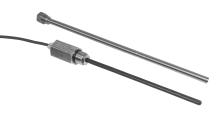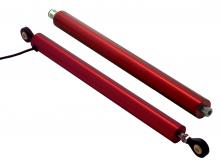Blog
In recent times, a major problem our customers have encountered is the need for a short to medium range position sensor that is rugged and does not wear out, but at the same time, is not unduly expensive. The low cost issue drives these customers to resistance potentiometers, but because they are not very rugged and utilize an internal sliding contact, they wear out pretty quickly. In fact, in motor sports applications, it is fairly common to observe pots being discarded after just one race. In factory automation related applications, pots are often used because of their lower initial cost, but they also introduce significant down time on the production line when they must be replaced because of wear.
On the other hand, customers found that contactless sensors like DC-LVDTs last much longer, but are substantially more costly and are relatively long compared to their range of measurement. Their poor stroke-to-length ratio can be a major installation problem, especially in automation machinery retrofit applications. Thus, many of our customers often found themselves entrapped by price-to-performance and reliability-to-cost issues or with difficult installation problems.
The solution for these customers focuses on LVIT (Linear Variable Inductance Transducer) sensors. LVIT position sensing technology offers the ruggedness and reliability of contactless operation, but with price points competitive to resistance pots, and with similar stroke-to-length ratios as well. We offer a wide variety of LVITs that are compatible with many industrial and mobile applications.
For example, LR-27 series LVITs work well on the outside of the hydraulic actuators on snow plows used for both highways and airports. LV-45 series of extra heavy duty sensors are used to monitor bridge expansion / contraction, as well as railroad track shift and rail “sun kink” to warn of a potential derailment. For civil engineering applications, the ruggedness and reliability of the LV-45 series take precedence over their size. For motor sports applications, the LR-19 series LVIT sensors with swivel rod eye ends are virtually exact mechanical replacements for the linear potentiometers previously used, but do not need to be thrown away after a race because they do not wear out and withstand the shock and vibrations particularly well. Because of LVITs’ very favorable stroke-to-length ratio, we can offer units for measuring up to 1 meter that are only about 6 cm longer than their nominal measuring range.
Besides these series, we offer high-pressure-sealed position sensors for operation inside a hydraulic cylinder that can be inserted into an O-ring port in the endcap of a cylinder, or be embedded inside the cylinder itself. In these applications, the cylinder rod has an 8 to 11 mm diameter gun-drilled hole that serves as the moving part of the sensor. Our ME, MHP, and MR series in-cylinder position sensors provide an analog feedback signal like an in-cylinder potentiometer at comparable cost but without the wear out problem associated with pots. In-cylinder LVITs cost substantially less than magnetostrictive sensors that may be chosen for hydraulic actuator applications where reliability and service life are the dominant factors. We also offer long stroke sensors like the LRL-27 series that can mount externally onto a hydraulic actuator that are equally suitable to give position feedback to a control system or PLC.
The designs for all of these LVIT products were driven by the need in the marketplace for an improved position sensor with a better price-to-performance ratio. Users wanted the advantages of a contactless but rugged sensor at an acceptable price compared to the rest of the components in their system. This issue was particularly important to OEMs that had been using DC-LVDTs in their automation systems in order to get maximum reliability compared to pots, but who were quite dissatisfied with the product cost. For automation and gaging applications, we developed the LRS-18 series of spring-loaded LVITs that can supplant spring-loaded DC-LVDTs of similar ranges for about half the price and have much shorter overall lengths, which can help to minimize any sensor installation problems due to excessive length.
Two key features of the built-in electronics of an LVIT that make it a particularly suitable replacement for a DC-LVDT, magnetostrictive sensor, or resistance potentiometer are its microprocessor, which permits linearizing the analog output to a high degree of precision, and an ambient temperature sensor that functions in conjunction with the microprocessor to effect wide range temperature compensation. When these features are combined with the exceptional robustness and superior stroke-to-length ratio of LVITs, they compete very effectively with the high precision associated with magnetostrictive sensors which can encounter reliability problems due to the fragility of their internal waveguide under shock and vibration conditions. This fragility was exemplified by a customer in a lumber mill using magnetostrictive sensors to control the sawing processes, in which very heavy logs were being loaded into feed cradles that received large shocks as the logs dropped into the cradles. Failed magnetostrictive sensors were stacked like cord wood nearby. When the sensor hardware was changed to LVITs, those shock-induced sensor failures were totally eliminated.
The conclusion is that sensors using LVIT technology can solve a wide variety of linear position sensing applications at low cost because they offer:
- Exceptional price-to-performance factors
- Contactless operation with no wear out
- Very good stroke-to-length ratio
- Extreme robustness to shock and vibration
- Temperature compensation over industrial temperature range
- Excellent linearity and repeatability
- Diverse application-oriented packages
- Pressure sealed versions for in-cylinder use




